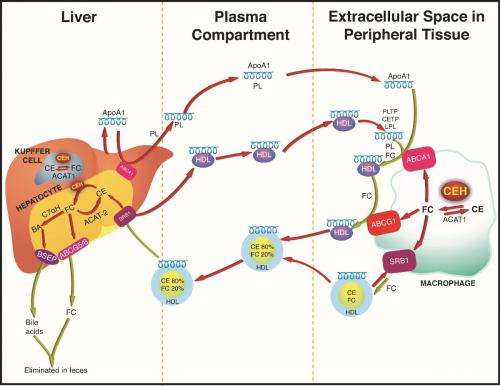Liver enzyme may play critical role in enhancing cholesterol removal from the body

(Medical Xpress)—The human body works hard to keep cholesterol levels in check. Cholesterol comes from diet and also naturally occurs in the human body. A large portion of the cholesterol occurring in the body is made in the liver, where its levels are also regulated. But an excess of cholesterol can occur, placing individuals at risk for developing coronary artery or heart disease, and the liver is the only organ in the body able to remove cholesterol.
Researchers at the Virginia Commonwealth University School of Medicine, led by Shobha Ghosh, Ph.D., professor of internal medicine, pulmonary division in the VCU School of Medicine, are conducting research aimed at understanding a key enzyme called CEH, which regulates the removal of cholesterol from cells and makes it available to HDL, or "good cholesterol."
In a new study, to appear in the November issue of the Journal of Lipid Research, Ghosh and colleagues report that CEH in the liver is critical for enhancing cholesterol removal from the body and establishes its cooperation with HDL receptor. In a preclinical model, the team observed that CEH worked together with a membrane protein called scavenger receptor BI, or SR-BI. Working together, CEH and SR-BI help drive a process to move cholesterol out of the body. They also observed how CEH helped catalyze important biologic processes and increased the flux of HDL-cholesterol to bile acids in vivo.
"Understanding the cellular processes that regulate the removal of cholesterol from the body is important for the development of new drugs that can enhance this process," Ghosh said.
"Drugs developed to increase the activity of this enzyme will reduce atherosclerosis (deposition of cholesteryl esters in artery wall) which is the underlying cause of coronary artery or heart disease."
According to Ghosh, although the team has identified the enzyme, additional research is necessary to determine how the activity of the enzyme is regulated. Ghosh said that moving forward the team will work to further understand the in vivo regulation of the enzyme and develop novel strategies to increase CEH activity by pharmacological means.
The study is titled, "Cooperation between hepatic cholesteryl ester hydrolase and scavenger receptor BI for hydrolysis of HDL-CE." The study first appeared online in the journal in August 2013.
More information: www.jlr.org/content/54/11/3078 … c6-8661-b59a38f78446


















